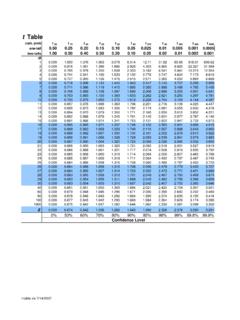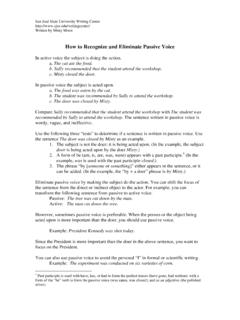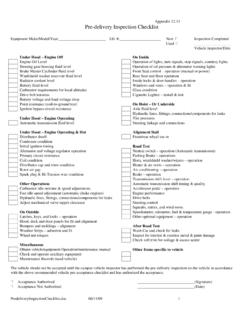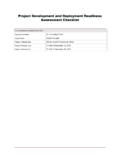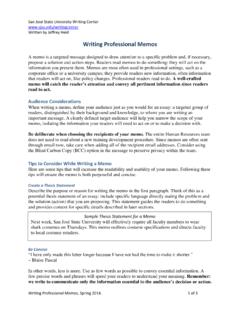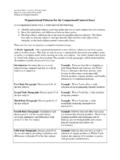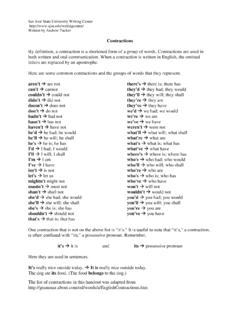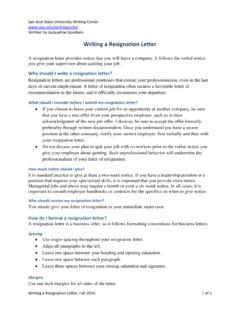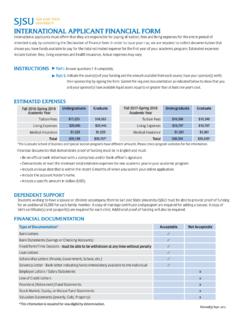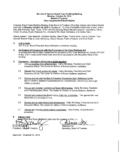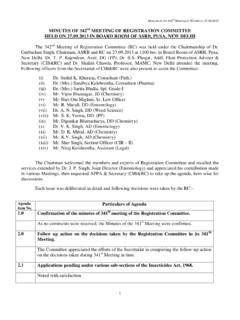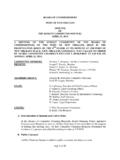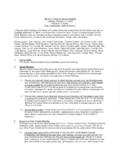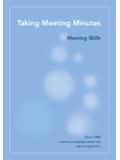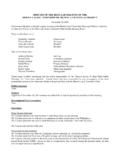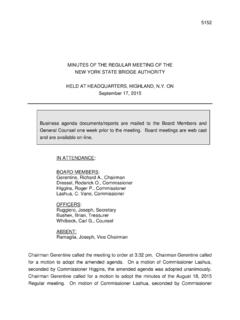Transcription of Lesson Plan: How to Write Agendas and Meeting …
1 Hart 1 Lesson Plan: How to Write Agendas and Meeting minutes Tabitha Hart Department of Communication Studies San Jos State University Lesson : How to Write Agendas and Meeting minutes Timeframe: 60 minutes Target Audience: Undergraduates, any major or year Materials needed: How to Write Agendas and Meeting minutes PowerPoint deck, laptop and projector, hard copies of Sample Meeting minutes for each student, hard copies of homework assignment for each student Note: The instructor should revise the Meeting background (slide 15) and Meeting agenda (slide 16) to suit class-specific needs and interests. Objectives: After this Lesson , students will be able to explain what an agenda and Meeting minutes are and why they are useful. identify the key components of Agendas and Meeting minutes .
2 Indicate strengths and weaknesses of sample agenda items and Meeting minutes . prepare a set of Meeting minutes . Background: Although this Lesson was originally developed for students enrolled in a Communication Studies course on Business and Professional Speaking, it is suitable for undergraduates of any major. No prior work is required for the students. The accompanying Power Point slides are designed as simple visual cues to help engage the students in the Lesson material. Introduction to Lesson [5 minutes ]: agenda ( Write on board): 1. Before a Meeting Agendas 2. During a Meeting using Agendas 3. After a Meeting minutes 4. Hold a small group Meeting 5. Homework - Meeting minutes Show slide two and define the term Meeting . A Meeting takes place when people come together (whether for work, clubs, sports, school, volunteer organizations, etc.)
3 For a purpose. Show slide three and pose these discussion questions to the class: o What was the last Meeting that you attended? o What made that Meeting satisfying/unsatisfying? Let students discuss the questions briefly with a partner before sharing their answers with the group. Student answers will likely include problems such as no set time frame for the Hart 2 Meeting , no agenda or plan, lack of participation, etc. Highlight these answers since they connect with the larger points covered in this Lesson . Show slide four and tell students that effective meetings are structured through writing. Point out the anticipated Lesson takeaways listed below. o Meetings are already a common element of your school/work/leisure routines o Meeting effectiveness can be weakened by not planning, not preparing a good agenda , not following the prepared agenda , not recording the decisions made, and not following up on decisions and plans.
4 O Meetings are structured through writing before, during, and after the event. Procedures [45 minutes ]: Step 1: Before a Meeting : How To Write Good agenda Items [5 minutes ] Show slide five and tell students that before a Meeting takes place, an agenda should be written out and distributed. Agendas are a powerful form of writing because they o help groups structure communication activity. o help people stay focused and on task. o provide a checklist of what exactly needs to be accomplished. o ensure that Meeting activities run according to time constraints. o generally make meetings more organized and productive. Show slide six and tell students that good agenda items are o specific. o results-oriented. o timed. o realistic. Show slide seven and point out that the sample agenda items on this slide meet our criteria.
5 All of them are timed, specific, realistic, and results-oriented. Good agenda items that are specific, goal-oriented, timed, and realistic Brainstorm news items for bulletin (10 min) Choose the logo for the website (15 min) Identify pros and cons of using Twitter (12 min) Update team members on budget (6 min) Step 2: Activity: How To Write Good agenda Items [5 minutes ] Show slide eight and point out that these are bad agenda items that do not follow our criteria. Bad agenda items that are NOT specific, goal-oriented, timed, or realistic Grad school applications Talk about financial aid Discuss marketing Create political campaign Hart 3 Ask students to fix these agenda items according to our criteria (see slide six). Review as a group. Step 3: During a Meeting : Using an agenda [2 minutes ] Show slide nine and point out that during a Meeting the agenda should be used and followed as closely as possible.
6 Show slide 10 and tell students that, when using an agenda , the Meeting participants will need to select three people to act as the Meeting chair, the Meeting note-taker, and the Meeting time-keeper. Each of these people will also participate in the discussion. Step 4: After the Meeting : Writing Meeting minutes [5 minutes ] Show slide 11 and tell students that Meeting minutes are written and distributed shortly after a Meeting takes place. The speed with which they are finalized and distributed depends on the norms of the organization. As they go forward, students will need to discover the expectations for finalizing and distributing minutes in the company/organization where they are holding meetings. Show slides 12 and 13 and distribute hard copies of the sample minutes . Point out the required components of Meeting minutes and explain as needed.
7 O agenda an exact copy of the Meeting agenda , including allotted times o Attendees who attended, who was absent, who came as a guest o Summaries of each agenda item discussed detailed enough so that anyone who was not present would get the gist by reading the minutes o Action items the next steps agreed upon during the Meeting , including what needs to be done by who and by when Step 5: Activity: Comparing and Contrasting Sample Meeting minutes [8 minutes ] Show slide 13 and introduce the activity on comparing and contrasting sample Meeting minutes . Have students work in pairs to analyze the sample minutes that you distributed in the previous step. Have students reflect on the following questions: o What are the strengths of these sample minutes , what is helpful, appealing, o What are the weaknesses of these sample minutes , what is unhelpful, unappealing, After two or three minutes of discussion, debrief as a group.
8 As you debrief, highlight the following aspects of Meeting minutes : o Level of detail. Provide enough details in the minutes to make them comprehensible to someone who was not there. As time goes on participants will forget the details, so having them in writing is will provide organizational memory. o Formatting. Formatting should be clean, appealing, and enhance (rather than detract from) readability. Clear headers help the reader locate different types of information. Sufficient spacing helps delineate where sections begin/end. o Structure/ordering. Meeting minutes have an expected structure. The components discussed earlier ( agenda , attendees, topics discussed, decisions made, and agreed-upon next steps action items) should all be included, and ordered in the same sequence. Hart 4 Step 6: Activity: Small Group Meetings [20 minutes ] Show slide 14.
9 Tell students that they will now work in groups of 3-4 people to hold a 15-minute Meeting using an agenda provided by you. Show students the agenda on slide 16. Tell students that as they engage in the Meeting , they must o stick to the agenda . o monitor the time. o participate in the discussion. o take notes. Note on the agenda : Select a Meeting topic suitable for your class. I chose a departmental study abroad program and included some background on slide 15. Modify the agenda on slide 16 to fit your topic. Sample topic Our department is planning to offer a new study abroad course to all majors. The course will be held in Berlin, Germany for three weeks in summer 2014. How can we best promote this course to our majors? Sample agenda 1. List five possible methods to promote the program.
10 (5 min) 2. Identify strengths and weaknesses of each method. (5 min) 3. Vote for the three best methods. (2 min) 4. Write three action items. (3 min) For the next 15 minutes allow students to hold their meetings. Ensure that all students are participating in the discussion and taking notes. Stop the meetings after the allotted 15 minutes are up. Closure/Evaluation [5 minutes ]: Ask the class the following questions: o What was interesting and/or challenging about this material on Agendas and minutes ? o What questions do you have about Agendas and/or Meeting minutes ? Show slide 17 and highlight what students have learned from this Lesson . Students can now o identify key elements of successful meetings. o Write specific agenda items with clear outcomes. o identify the key components of Meeting minutes .

